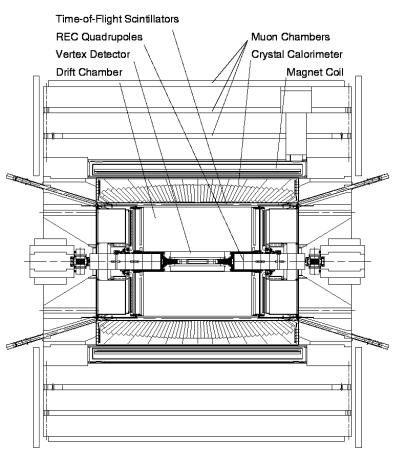
CLEO II is a multipurpose high energy physics detector incorporating excellent charged and neutral particle detection and measurement, used to analyze electron-positron collision events generated by the CESR 10 GeV storage ring. The CLEO II detector is operated by a collaboration of over 100 physicists from many institutions, including CalTech, UCSB, UCSD, Carleton University, CMU, Colorado, Cornell, Florida, Harvard, Illinois, Kansas, McGill, Minnesota, SUNY Albany, Ohio State, Oklahoma, Purdue, Rochester, SMU, Syracuse, Vanderbilt and Virginia Tech.
The detector itself is about 6 meters on a side, containing about 900,000 kilograms of iron and over 25,000 individual detection elements. The figure above is a side view cross-section of the detector, with the electron-positron beam passing through the center of the detector in the plane of the figure (a view from one end of the CLEO detector is also available). The electron and positron beams collide and annihilate in the center of the detector, producing new, sometimes exotic and unfamiliar, matter--particularly b quarks. Most final state particles created in the collision pass through the beam pipe and enter the detector, though some particles travel along the beam pipe and thus escape detection.
For more information on a particular detector element, click on that element in the figure above, or a pick a detector element here:
For technical details on the CLEO II detector, see Y. Kubota et al., Nucl. Inst. and Meth. A320, 66 (1992). To arrange a tour of Wilson Lab contact the Wilson Lab office at 607-255-4882.